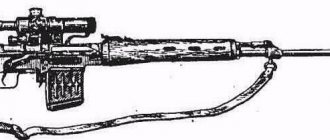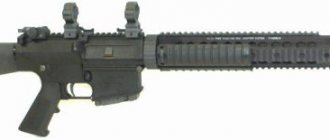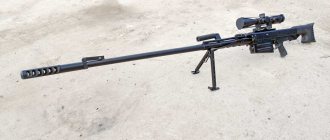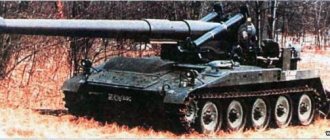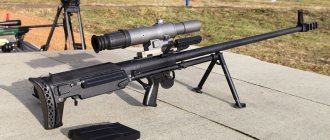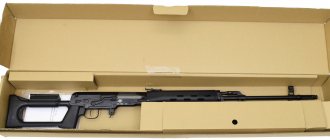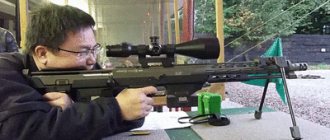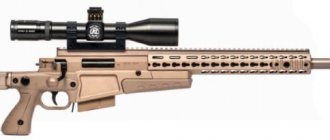SV-98 is a Russian non-automatic sniper rifle, developed by a group of designers led by V. Stronsky in the late 90s. Currently it is produced at Izhmash. The rifle is designed to destroy enemy personnel, both unprotected and with personal armor protection.
Production of the SV-98 began in 2004; a year earlier it was put into service. Currently, the SV-98 sniper rifle is used by special units of the FSB, FSO and the Ministry of Internal Affairs of the Russian Federation. The Ministry of Defense is looking closely at this weapon; it is possible that in the future the SV-98 will replace the well-deserved, but already obsolete SVD sniper rifle. In 2010, more than 50 SV-98 units were purchased by Armenia.
How the SV-98 was created
The SV-98 sniper rifle was created on the basis of the Soviet Record sporting rifle, developed in 1972. More precisely, one of the later modifications of this weapon is “Record-SIZM”. This rifle was created after the collapse of the USSR, especially for the Russian CSKA team. It should be noted that this path to creating a combat sniper rifle is by no means unique: the creators of the Blaser R93 Tactical followed exactly the same path.
The differences between the SV-98 and the SIZM are very small - a detachable magazine for ten rounds, a thicker barrel with a thread for installing a PBS. In addition, the SV-98 has a fuse (it is not on Record-SIZM), a bipod and a carrying handle. The standard modification of the rifle, in addition to the universal bracket for mounting an optical sight, is equipped with open sights.
The new sniper rifle, and chambered for the standard 7.62×54 mm cartridge, naturally attracted the interest of the military. In addition, the prototype (“SIZM”), on the basis of which the SV-98 was created, provided the new weapon with excellent accuracy.
The fact is that until now the main sniper rifle of the Russian army is the SVD, which, despite all its undeniable advantages, has long been obsolete. If Russian military personnel have an excellent Vintorez rifle for silent shooting, and at long distances they can use OSV-98 or KSVK, then the niche of the main sniper weapon has remained vacant. The SVD is 100% a product of the Cold War era, when generals were preparing for epic battles involving millions of armies. The SVD even has a bayonet mount, which today can only cause ridicule. This rifle is very durable, reliable, with an excellent rate of fire, but its shooting accuracy clearly does not meet modern requirements.
Today, army snipers are trained in special centers, where they are not only taught to shoot, but also introduced to the tactics of sniper units, the basics of camouflage and many other intricacies. A well-trained shooter also needs the appropriate weapon. For fighters of special units, they usually buy foreign sniper systems, but there is still a problem with mass-produced weapons for army snipers in Russia.
There is no decision yet on adopting the SV-98 rifle. Although, this rifle would be perfect for the Russian Armed Forces. One of its main advantages is the use of standard ammunition for the SVD rifle (7.62 × 54 mm R). Establishing the production of new cartridges for sniper weapons is a very difficult and quite expensive task. Her decision could take years. In addition, the SV-98 cannot be called a completely new weapon. It is very familiar to Russian athletes and instructors, who have studied it thoroughly over the years of training.
In 2013, the rifle was modernized. It received a stock and butt made of aluminum alloy, as well as additional mounts for attachments and a new design of PBS, which made the sound of the shot even quieter.
Sniper rifle SV-98 caliber 7.62 mm. Device
SV-98 (GRAU Index - 6B10) is a Russian repeating sniper rifle, was developed by the team of NPO Izhmash (now Kalashnikov Concern) under the leadership of Vladimir Stronsky in 1998-2000 on the basis of the Record-CISM sports rifle. The weapon is designed for high-precision destruction of enemy personnel at ranges of up to 1000 meters. In 2013, the weapon underwent minor modifications.
Description of design
The SV-98 is a non-automatic rifle with a detachable magazine and a sliding bolt that is locked with three lugs. Naturally, in terms of its rate of fire it is inferior to self-loading rifles of the SVD type, but it is significantly superior to them in terms of shooting accuracy. The operation of automation always causes additional fluctuations, which has the most negative impact on the effectiveness of sniper weapons.
The barrel and chamber of the rifle are made from a single piece using the cold forging method. The barrel is manufactured using equipment from the Austrian company GFM; the entire process is fully automated and computer controlled. Even the installation and removal of the barrel is done by a robot. After forging, it is kept for some time so that the stresses inside the metal go away, then the honing process follows, and only after that the barrel is sent for heat treatment. The bore is not coated with chrome, which somewhat reduces its survivability, but has a very positive effect on shooting accuracy. At the end of the barrel there are mounts for installing a muzzle brake or muffler.
The silencer does not impair the accuracy of the SV-98's shooting; moreover, it makes it more comfortable, reducing recoil by about a third.
The barrel and receiver are connected using pins. In this case, the barrel does not touch the rifle stock - such a solution is quite common for sniper weapons. Thus, the grip of the weapon does not affect the aiming point, which is quite important for high-precision shooting. The stock of the SV-98 is made of aircraft plywood, there is a groove for a folding bipod, and in the central part there is a handle for convenient transportation of the weapon.
The structure is attached to the cradle using two screws. The SV-98 has an adjustable butt plate and cheek rest; they are adjusted to the individual characteristics of the shooter. The stock of the latest modifications of the rifle is made of aluminum alloy. The rifle's forend has two ventilation holes, and the pistol grip has a notch.
The SV-98 has a trigger mechanism (trigger mechanism) with an adjustable trigger force, which is typical for sporting weapons. The rifle is equipped with a two-position safety that simultaneously blocks both the bolt and the trigger. It is located in the rear of the receiver, on its right side, next to the bolt handle. The rifle is reloaded manually and can only fire single shots.
The rifle is fed from a detachable magazine with a capacity of ten rounds. The magazine has a hole to detect the presence of cartridges, as well as a guide mechanism that allows it to be “blindly” attached. The rifle's magazine is double-row, it is made of durable plastic (polyamide) and has metal inserts. The magazine mounting mechanism is more reliable compared to the SVD rifle.
The SV-98 has open sights, which consist of a front sight in a front sight and an open adjustable rear sight with a scale from one hundred to six hundred meters, in increments of one hundred meters. However, the main sighting device is the optical sight. This rifle has a method of mounting the “optics” that is different from the well-known “dovetail”, which is used on the SVD. On the top of the receiver there is a mounting rail on which you can install a 7x PKS-07 sight or a more powerful Hyperon. In addition, you can use several types of night and thermal imaging sights for firing at night.
The standard equipment of the weapon includes the following elements: a handle and a carrying strap, a low-noise firing device, an antimirage tape for the barrel, a special reflector visor for the silencer, a set for cleaning and maintaining the weapon, a bracket for installing an optical sight.
SV-98 power supply and sighting devices
The SV-98 magazine is box-type and holds 10 rounds. On the left side of the removable magazine there are special holes with markings, by which the sniper can find out the number of cartridges remaining. In order to quickly replace a depleted mechanism in a combat situation, it was equipped with an original guide mechanism. The SV-98 magazine is made of polyamide with glass filling. For strength, it was reinforced with metal liners. The magazine latch secures it firmly to the receiver, preventing the magazine from spontaneously falling out.
The sniper rifle uses both optical sights and open sights as sighting devices. The latter are used as an adjustable rear sight and front sight in the front sight. Although the front sight itself is completely copied from the SVD, its base is of an original design. The front sight can be adjusted vertically and horizontally. The rear sight is equipped with a distance scale and assumes shooting at a distance from 100 to 600 meters. Shooting at longer distances with open sights is very problematic.
The optical sight is mounted on the SV-98 sniper rifle using a dovetail mount. Early releases were equipped with the PKS-07 sight, then it became possible to order the SV-98 with the Hyperon pancratic sight. For night operations, the SV-98 rifle can be equipped with a wide range of night vision sights.
For better cooling of the rifle barrel, its forend has 2 ventilation holes. For better grip of the weapon, the pistol grip is equipped with a notch. Since the new concept of a sniper rifle assumes complete individuality of the weapon, the adjustable stock can be adjusted to the anatomical capabilities of any shooter. The wooden stock is also adjustable. In the front part there is a mount for a bipod.
To fire the SV-98, you can use various types of 7.62x54 mm ammunition. Moreover, the rifle shoots perfectly with both domestic and foreign ammunition.
Accuracy
The rifle has excellent accuracy and allows for fairly effective fire at distances of up to 800 meters. At a distance of 300 meters it is 0.5-0.7 arc minutes, which allows the shooter to confidently “put” bullets in a circle with diameters of 76-78 mm. For comparison: the SVD at the same distance gives a spread of 15-17 cm. A good shooter, using special ammunition, can hit a tall target at a distance of 1200 meters. It should be noted that the SVD can only fire “harassing” fire at a distance of 800 meters.
Compared to the SVD, the SV-98 rifle has large dimensions, which in some situations can be a problem (for example, in mountainous areas). The attitude of the soldiers towards the new rifle is still a little wary due to its untested by time and operation. The SV-98 is often treated as a competition rifle.
Why the famous SVD should retire
The famous SVD sniper rifle, which served faithfully in the USSR army since 1963 and continues to be the main sniper rifle of the Russian army, is no longer relevant in modern conditions. Since the SVD was developed during the Cold War, the requirements for it were oriented towards a global war. The fact that the SVD has a standard mount very eloquently hints that the Soviet sniper was an ordinary soldier who was obliged to go into a general bayonet attack.
It is for this reason that the SVD was developed in accordance with the following characteristics:
- The rifle must be trouble-free and reliable;
- Rapid fire;
- The rifle's accuracy should have been sufficient at a distance of about 500 meters.
Since optical sights did not have outstanding characteristics until the early 80s, the 500 meters at which the SVD can operate effectively was quite enough.
The war in Afghanistan showed that in such local conflicts, the structure of the USSR army, which is focused on waging a large-format global war, is extremely ineffective. The role of the sniper has increased significantly; now he must be not just a fighter wielding a sniper rifle, but a real specialist who can solve various combat missions while remaining unnoticed by the enemy.
Despite numerous attempts to modernize the SVD, nothing good came of it. That is why new models of sniper weapons began to appear in the arsenal of Russian snipers. The famous VSS Vintorez and large-caliber sniper rifles, like OSV-96 or KSVK. However, it should be understood that all of the above rifles are very expensive, so it is not possible to equip all army snipers with such weapons. It is for this reason that SVD is now beyond competition.
Modifications
There are several modifications of the rifle:
- Basic modification of the SV-98 chambered for 7.62x54mm R caliber.
- The SV-98M-338 is a prototype weapon developed in 2000 and chambered for the .338 Lapua Magnum cartridge.
- KO-13 “Record” is a civilian modification of the weapon, the small-scale production of which began at Izhmash in 2010. The main difference between this modification is the absence of a muffler mount on the rifle barrel and a carrying handle.
- A modernized rifle with a stock and butt made of duralumin alloy. This option is more ergonomic and lighter.
- Export modification chambered for the NATO cartridge 7.62×51mm (.308 Win).
- A modification of the rifle with a lightweight skeleton-type stock, folding bipod, adjustable buttstock made of black plastic and a new optical sight DH 3-12x50, on which you can install the Dedal-TA2 thermal imaging attachment. This version of the SV-98 was demonstrated at the Eurosatory-2014 arms exhibition, which was held in Paris.
MAKSIMOV.SU
Like many models of domestic small arms, the SV-98 rifle has been the subject of countless discussions since its introduction.
The rifle was evaluated both by comparison with the three-line sniper and SVD, and with available imported analogues. After the first few years of operation of the SV-98 in special forces, a more or less clear opinion was formed among snipers about the new product.
This article
could be written based on an analysis of the use of the SV-98 by snipers of various law enforcement agencies, but such materials are available and have been repeatedly analyzed by the interested public.
Therefore, an assessment of a rifle without direct reference to the specifics of combat use, so to speak, “through the eyes of a hunter,” based on some personal experience, seemed to be a more acceptable format for presenting the material. It didn’t quite work out, but it is what it is.
I’ll point out right away
that an almost identical analogue of a combat rifle (called “Record”) can also be purchased by a civilian user.
Design Features
Just in case,
Let us recall the design features of the rifle. So, the SV-98 sniper rifle, the prototype for which was the Record-CISM army sporting rifle (built, in turn, on the basis of the 1-shot high-precision Record rifle chambered for 7.62x54R), is designed to destroy targets at range up to 1000 m. SV-98 is a weapon of highly qualified snipers and is not intended for arming conventional army units.
Reloading is carried out by a longitudinally sliding bolt,
with cartridges fed from a ten-place detachable magazine. The design of the weapon allows the installation of almost any modern optical sights. To attach them, a Picatinny rail is made along the top of the receiver. The 1P69 sight is used as a standard sight. The PKS-07 optical sight is also installed. The rifle is equipped with open sights.
Fuse
blocks the travel of the trigger, locks the sear and bolt. The trigger mechanism allows adjustment of the trigger force.
Stock SV-98
it is convenient for shooting from any shoulder, has adjustment of the length of the butt, the position of the back of the head and the comb of the butt vertically and horizontally. The stock is equipped with a quick-release bipod in the front part of the fore-end and a bipod in the butt. In the stowed position, the bipod folds into the fore-end and butt and does not protrude beyond the dimensions of the stock.
To reduce the sound level of a shot
, reducing recoil energy, eliminating muzzle flash, the SV-98 can be supplied with a tactical silencer. The free-floating barrel is made by rotational forging. The package also includes a case, carrying handle, and anti-mirage tape. In terms of technical dispersion, the rifle is equivalent to the best models of sporting weapons. The accuracy of combat with high-quality cartridges is about 50-70 mm at a distance of 300 meters. Effective firing range is up to 800 meters.
R developers
Rifle development
was carried out under the leadership of the head of the design bureau of the department of the chief designer of IZHMASH Vladimir Dmitrievich Stronsky. Designers Nikolay Andrianovich Mitryukov, Leonid Nikitovich Sterkhov and Mikhail Yuryevich Golovanov took direct part in the work. After Stronsky retired, production support and modernization of the SV-98 was carried out under the leadership of Golovanov.
SV-98.
Holding it in your hands
When you first take the SV-98 in your hands,
then you immediately understand that even taking into account possible modifications, this rifle is not very suitable as a classic hunting weapon - its dimensions and weight are not very conducive to this. I do not take into account those mountain hunts where accuracy (especially the first shot) is more important than relative compactness and low weight - horses, mules and donkeys have not yet been canceled, and there are still people who carry 6-7 in the highlands without any problems -kg rifle and 30-kg backpack. Of course, there are specialized rifles for long-term hunting in the mountains, but this is a separate topic for discussion.
Bolt group
and
trigger Shutter SV-98
has three symmetrical lugs and, as is typical for domestic weapons, is very simple in design and can be easily disassembled for maintenance. Locking is done on the lugs in the receiver. The role of cutting off the second cartridge (the flange is required) is performed by a special bolt part located at the bottom of its stem. A cocked firing pin is indicated by a cocking indicator located at the rear of the bolt (determined tactilely and visually). The extractor is spring loaded.
But from a “modern” spring-loaded reflector
the designers refused. This has drawn criticism. Moreover, what is noteworthy is that, first of all, criticism came not from direct users of weapons, for whom normal manipulation of the shutter usually does not present any difficulties, but from Internet theorists.
The reliability of the SV-98 reflector is beyond doubt, which is confirmed by practice. And let’s not forget that the ability to dose the force of reflection of a cartridge case is an important factor when using sniper combat weapons. And hunters often prefer to take the spent cartridge with them. It doesn’t matter if it’s for later re-equipment or as a keepsake.
Gate surface
has a cadmium coating. This is a fairly rare and expensive material, so it is rarely used for applying protective coatings. But such a coating, in its protective properties, is superior to zinc and best protects the metal product from corrosion, incl. – in difficult operating conditions.
And in our case, the cadmium layer also serves to reduce friction of the bolt stem when moving in the receiver of the rifle. For reference: for the first time at IZHMASH, cadmium coating was used on the trigger of the Nikonov AN-94 (Abakan) assault rifle.
Receiver SV-98
has a complex shape. The lower part of the box has multi-directional transverse ribbing. In combination with laying the “iron” in the stock with epoxy resin-based mastic, fins have a positive effect on the positioning of the “iron” in the rifle stock, stability and accuracy of combat.
Laying the receiver in the stock with mastic is exactly what has been practiced in domestic factories for several decades and now bears the fashionable borrowed Western name “bedding.”
USM rifles
has the ability to adjust the stroke length and trigger force. The trigger is ergonomic and has a longitudinal notch.
Shop
Shop
with a double-row arrangement of cartridges. The body is made of polyamide, the feeder is metal. The magazine fixation is interesting - in the shaft there is a vertical guide in the form of a rod, along which the front part of the magazine slides when it is removed and attached to the weapon.
The magazine is securely secured to the same rod with a transverse spring-loaded clamp. To remove the magazine, you need to press the large release button and remove the magazine downwards.
For a shooter familiar with SVT and SVD,
Filling the SV-98 magazine with cartridges does not cause any difficulties. Attaching a magazine requires minimal skill and is even somewhat simpler than attaching a magazine to an SVD.
SV store
has an original feed mechanism, but is easy to maintain and, as mentioned above, absolutely reliable. At least, I have never heard about problems with supply to SV-98 (from a representative number of users), starting around 2005.
Fuse
Lever type fuse.
It is located where the rifle's safety should be - in the right rear part of the receiver. Turns on and off by moving forward and backward. Convenient, understandable, simple and reliable. No complaints.
Barrel
The bore of the SV-98 is not chrome plated,
which is uncharacteristic for Russian military weapons. This is explained by the higher accuracy of the barrel without chrome coating, which distorts the geometry of the barrel. Critics of the SV-98 argue that for the sniper the “black” barrel causes additional problems associated with the need for more careful maintenance. But the snipers themselves (we are talking about special forces units) do not see any particular problems in this.
Interestingly,
If there is a conversation about the effectiveness of the SV-98 and “in general,” then snipers are inclined to believe that the SV is more suitable for the so-called. “police” operations, but for “war” a semi-automatic is still more acceptable. And we are talking specifically about SVD.
SV-98 barrel survivability
quite high. There are known specimens that have fired about 10 thousand rounds and continue to fire with sufficient accuracy.
The barrel is hung,
those. does not come into contact with the rifle stock anywhere. There is a thread on the muzzle of the barrel, which makes it possible to mount both a full-fledged muffler (everyone calls it “tactical”) and a powerful flame arrester (we are talking about a coupling that covers the mounting cone of the muffler).
Possibility of using anti-mirage tape
more relevant for varminting and benchrest, although it can certainly come in handy in the mountains. Special forces snipers on combat missions usually refuse to use tape.
Open sight
"Mechanics"
It is represented by a traditionally adjustable vertically and horizontally adjustable front sight in the front sight and a drum-type sight, “cut” up to 600 m, with adjustment increments of 100 m. Everything is done simply and reliably, the sight is quite convenient, despite its auxiliary purpose.
At least, when shooting standing (from a sling), a chest target from an open rifle sight can be hit without problems at a distance of 300 m, and a tall target can be confidently hit while lying down at a distance of 500 m.
If someone claims that “mechanics” is unnecessary
on a combat rifle - let this remain his personal “modern” opinion.
Optical sight
Unfortunately,
Instead of the Hyperon, the rifle was equipped with a PPO 3-12x36F - an optical pancratic sight, with illumination and a reticle similar to the PSO-1. Those. - quite a military device. The sight was outwardly completely unpresentable (in this regard, not much different from a well-worn rifle), but at the same time it showed acceptable performance.
Yes, there was some yellowness and cloudiness of the “picture”, because the sight had long ago lost its seal (if it was there initially), but this did not have a particularly critical effect on accuracy (at relatively close distances).
Any optics can be installed on the rifle,
with suitable fastenings. The “torn” Weaver rail caused some confusion, although, on the other hand, we can see exactly the same separate seats on many modern rifles.
But, I repeat, installing optics on a rifle is not a problem. According to unverified information, subsequent releases of the SV-98 received a full-fledged “rail” along the entire length of the receiver.
Stock and bipod
Stock SV-98
It has an ergonomic design, is made of high-quality veneer and has a range of adjustments to suit almost any user. The sporting past of the rifle and its current purpose are reflected. The idea of using bipods that can be retracted into the fore-end is not new and was well implemented in the example of the SV-98.
The rifle's stock has sparked online debate.
But critics' attacks on the material of the SV-98 stock are unfounded. The same Germans still use veneer on their sporting high-precision rifles (for example, “Anschutz”). Veneer is an excellent, stable and, importantly, “warm” material, almost ideal for precision weapons.
Plastic, no matter how it is advertised, cannot be compared with veneer, that’s a fact. Non-believers can always put their cheek to the plastic butt in the cold of 30-40 degrees and talk about their feelings. The problem with veneer stocks is that now they have stopped making normal veneer, and it has become very expensive.
This is why the original “ZIP” Soviet veneer sets of stock and fore-end overlays for SVD are now so valued, and so often there are counterfeits made from ordinary laminated plywood.
Convenient removable handle
for carrying weapons, located in the center of mass of the rifle. For some types of hunting it may not be superfluous. Somewhere there was criticism about the nuts securing the handle to the stock, but in practice these “wings” do not interfere.
SV-98.
Rifle accuracy
SV-98 rifles
are accepted by the military acceptance office (customer's representative) based on the results of shooting at 300 (three hundred) m. In this case, the dispersion should not exceed 90 mm, which fits into the notorious Western standard - 1 MOA (about 30 mm at 100 m). Simply put, the accuracy of the rifle meets all modern requirements. If it is possible to use selected ammunition (it doesn’t matter, a good “Extra” or self-assembled), “98s” that have not been shot into trash show results at the level of 0.5-0.75 MOA.
Our rifle
confidently fired groups of 5 shots within 1 arc minute (there were gaps of up to 1.5 MOA due to the fault of the shooters) with the 7N1 cartridge at distances from 100 to 300 meters. “Extra” flew more closely: consistently less than 30 mm per hundred, at 300 m the result was within the expected 90-100 mm, but to obtain the maximum result at this distance there were no longer enough capabilities of the sight.
With fairly fast shooting with optics, a chest target up to 600 m is hit without misses. A target the size of a person’s head, even with a poor “Extra” sight, can be hit at a distance of up to 400-500 m, but taking into account adjustments. In such conditions, the need for a really good scope is most acute.
"Dulnik" works well
– no flash is observed at dusk. The store has no complaints. Reloading is smooth and there is no need to apply any effort (the bolt group has not undergone any grinding or fine-tuning). Considering the small amount of fire the rifle has fired (500 rounds), there is also no need to talk about any significant natural grinding in.
The descent is beautiful - the sporting past of the SV-98 shows. Thanks to the comfortable and individually adjusted stock and the significant weight of the rifle, recoil is practically not felt, shooting is a pleasure and gives the shooter confidence in his abilities.
Conclusion
Is SV-98 suitable?
(that is, its civilian version in the form of “Record”) for hunting and, in general, for sporting use by our fellow citizens? The answer is simple and obvious: yes, it does. In the same way as all models of domestic military and conversion weapons in civilian use have been, are suitable and will be suitable (no one has yet proven the opposite).
I don't want to touch on all the details
combat effectiveness of the SV-98, let the “special forces” snipers working with this rifle and Internet theorists argue about this. This article discusses the use of the CB analogue in hunting.
Facts of using “Records”
I personally don’t know about classic driven hunts. But they shoot animals from ambushes, especially when there are more or less significant distances. Enthusiasts also go to the mountains with these weapons. And successfully. Owners of “civilian” SV-98s also shoot at “paper” effectively.
Yes, an “almost real” SV costs money and ordering such a rifle is not so easy. But, you see, everyone has their own “wants” and criteria for evaluating weapons and their effectiveness.
In the meantime, the domestic “green rifle”
continues to serve in the Russian Armed Forces and pleases the few owners of the civilian version of the SV-98.
The article was published in the magazine “Master Gun” in September 2013
